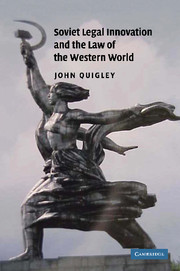Book contents
- Frontmatter
- Contents
- Abbreviations
- Preface
- Acknowledgments
- PART ONE THE SOVIET CHALLENGE
- 1 The Industrial Revolution and the Law
- 2 Economic Needs as Legal Rights
- 3 Equality in the Family
- 4 Children and the Law
- 5 Crime without Punishment
- 6 A Call to “Struggling People”
- 7 The Withering Away of Law
- PART TWO THE WEST ACCOMMODATES
- PART THREE THE BOURGEOIS INTERNATIONAL ORDER
- PART FOUR LAW BEYOND THE COLD WAR
- Notes
- Bibliography
- Index
1 - The Industrial Revolution and the Law
Published online by Cambridge University Press: 27 July 2009
- Frontmatter
- Contents
- Abbreviations
- Preface
- Acknowledgments
- PART ONE THE SOVIET CHALLENGE
- 1 The Industrial Revolution and the Law
- 2 Economic Needs as Legal Rights
- 3 Equality in the Family
- 4 Children and the Law
- 5 Crime without Punishment
- 6 A Call to “Struggling People”
- 7 The Withering Away of Law
- PART TWO THE WEST ACCOMMODATES
- PART THREE THE BOURGEOIS INTERNATIONAL ORDER
- PART FOUR LAW BEYOND THE COLD WAR
- Notes
- Bibliography
- Index
Summary
From the moment the bolsheviks took power in Russia, Western governments worried that the Soviet idea might spread. Earlier revolutions had spread like a “contagion” – the Papal Revolution of the twelfth century, the Protestant Reformation of the sixteenth century, the English Revolution of the seventeenth century, the American Revolution of the eighteenth century.
These revolutions, wrote Harold Berman, had “enormous all-Western repercussions,” namely, “a reaction of fear and hostilities in other countries – fear of the spread of the revolutionary virus, hostility toward the nation that was its bearer.” The Western world was united by ties of history and the kinship of the monarchies. What happened in one country affected another.
The process of reaction to revolution, as described by Berman, was that “when the revolution had settled down in its home country, the other countries accepted a mild version of it.” Berman detailed the impact of these revolutions, including the Bolshevik: “after the Luther revolution had subsided in Germany, absolute monarchies with a strong civil service appeared in England, France, and other countries; after the Puritan Revolution had subsided in England, constitutional monarchies and quasiparliamentary institutions emerged on the European continent in the late 1600s and early 1700s; after the French and American revolutions had subsided, the English enlarged the electorate to include the middle classes in 1832; and after the Russian Revolution had subsided, ‘socialist’ or ‘new deal’ governments appeared in the 1930s in Western Europe and the United States.”
- Type
- Chapter
- Information
- Publisher: Cambridge University PressPrint publication year: 2007



